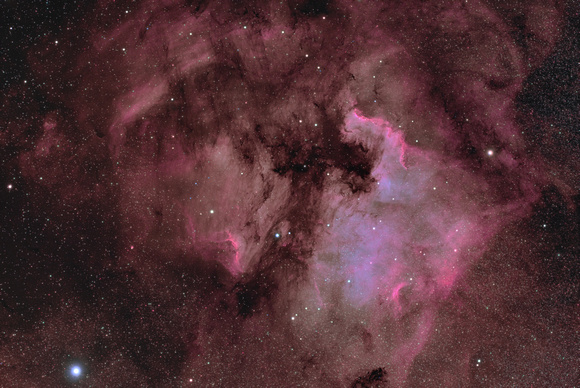The North America and Pelican Nebulae in NB, Widefield
SH2-117, North America / Pelican Nebulae in Dual Narrowband, Cygnus, Widefield
Sep 2022
Williams Optics Redcat APO 51; - ASI2600MC;
Celestron CGEM II; IDAS NBZ Nebular Booster Filter;
103 x 540s exposures, Bin 1, Gain 100;
Total Integration Time = 15.5 hours;
The North America et al Nebulae form one of the most imaged targets in the night sky. Indeed my first ever deep sky image was of this target. One can see that really, they components form one large gaseous (hydrogen) complex, and looks to me like a long dog (Dachshund?) curled and biting its own tail in the upper right (so I displayed it upside down from convention). The complex is 2600 light-years away and 140 light years across. The apparent separation between the N.A. and Pelican emission nebulae is provided by the dark nebula that also obscures the hot ionizing star that energizes the cloud to make it shine. In fact, from this image, it appears that the "separation nebula" may be overlain in the foreground by a second dark nebula.
I am really happy with the way my North America et al nebulae turned out. I tried to bring out much of the dimmer details of the nebula, particularly the dark stuff, but still retain definition in the Cygnus wall (and the other two "walls" at 4:30 and 7:30). If you think I was successful at this, I have to put the credit to integration time, careful deconvolution, and stretching using GHS.
I am pleased that I was able to capture some pillars/fingers in the brighter areas.
Certainly, my subframe rejection rate was very high due partly to smoke/haze, the full moon, but also glitches I made while learning.
In some ways, wider fields are just another fractal dimension of long focal length images, but in other ways they present other challenges. Having the camera sensor orthogonal is much more important for wide fields - and apparently I have more adjustments to make. Correcting misshapen stars added a huge challenge to me and took considerable time. Better to spend the time making the camera closer to orthogonal!


